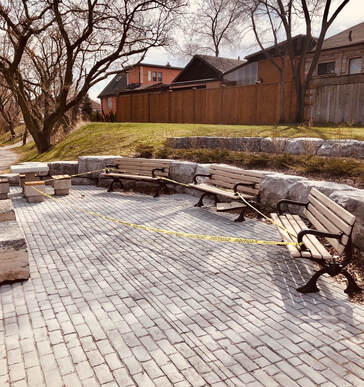With Dr. Roger Keil, originally published by the Ontario Planning Professional Planners Institute on April 27, 2020. Foreword “What do you think will happen to cities?” is a question I and my fellow planners get asked often in these days of social isolation. Our families and friends are curious, and perhaps even a bit worried, about what our communities could look and feel like on the other side of this crisis. We are too, believe me. But we are hopeful, we have to be. The pandemic and ensuing lockdown has generated a renewed energy across our cities, and certainly in Toronto, for creating safe and attractive spaces for people to gather and move – calls for more and improved public parks, wider sidewalks, and longer stretches of bike lanes, mostly. Missing from this renewed interest in city health, however, is a discussion about who gets to have access to these spaces and opportunities in our cities. COVID-19 is indeed a catastrophic health emergency, and creates with it an economic fallout of matching impact, but another and more pervasive emergency is structural social inequality borne out of decades of inequitable distributions of wealth and opportunities across cities among our fellow residents. We are indeed “in this crisis together” but the lived experience of this crisis – the ability to self-isolate and continue to work, for example – is vastly different for people. There is a loud chorus of “things will get back to normal” but if normal means the continued systemic marginalization of vulnerable groups – our poor, elderly, Indigenous peoples, racialized communities, LGBTQ + , the differently-abled – this should not, will not be acceptable. So, where do we go from here? Below, my friend and colleague, Professor Roger Keil from York University, and I shared some thoughts to an ongoing discussion about planning in these challenging times, led by the Ontario Professional Planners Institute (OPPI).  Finding a new frequency "A pandemic doesn’t care about social inequalities, but it does follow them," Jesse Wente said recently on CBC Radio One. This message, we think, could have been the call we planners needed to refocus our thinking and actions in this ‘Planning in (and beyond) the Time of Covid-19’ reality. While the pandemic and ensuing lock down has undoubtedly validated the good planning tenets of creating healthy communities with access to public spaces and active transportation options such as cycling, for example, the bigger issue of who gets to participate in and reap the rewards of this pursuit remains largely unnoticed and untended. While planning, the discipline, rightly uses this time to contemplate and possibly re-calibrate a post-pandemic future, many people – in fact large sectors of the public – are without such an opportunity. Many residents, disproportionately the already-vulnerable living at the economic and spatial margins of our communities, have no choice but to put themselves at risk stocking groceries, preparing food, delivering on-line orders, and caring for the elderly. They also tend to live in the highest densities, are most dependent on sharing space while in transit and make their living in crammed, often dangerous workplaces shoulder to shoulder with co-workers. Life does indeed go on and, as before the pandemic, vast differences in the lived experience persist and come into ever starker contrast across the rural, urban and in-between expanse. Making the invisible visible We should be asking ourselves, and each other, some uncomfortable yet important questions like, “Who are we speaking with and planning for?” and “Who gets to have access to good parks and cycling infrastructure?” and “Who are we leaving behind?” Despite our virtuous intentions we are, for the most part, a privileged group of well-educated and upwardly-mobile professionals who are players in an inherently political and market-driven game calibrated for picking winners and losers. There are of course tools in place including public consultation and financial contributions to generate better outcomes for more people, but without a deeper and broader consideration of who we’re actually planning for, and with their needs at the centre, no planning discourse inside or outside a crisis like Covid-19 will be enough to shift the paradigm. While planners and other community-builders advocate for and work towards physical and social improvements within our environment, inequalities borne out of structural inequities persist. Infrastructure and services for example, of which convenient and safe access to education and recreation opportunities is a marker, are deployed unevenly leading to spatial, as well as social and economic, peripheries. Such divides within and across our communities were well-entrenched before, have become quite pronounced during, and could very well worsen after the current pandemic. This is not all new and surprising. The challenges put before us by this pandemic are not far removed from the ongoing demands of the climate emergency: our urban world is in deep distress and the way we have been planning for and building our cities may have exacerbated the situation. Answering the (silent) alarm Planning is often influenced by catastrophic events including disease outbreaks, and accordingly planning theory and practice come to reflect changes in how cities are governed and built. Retrospectives and lessons learned have been written in the aftermaths, viewing cities as put “under siege” by pandemics, and in Canada before the current Covid-19 crisis such a city was Toronto during the SARS outbreak in 2003. Limiting “sieges” as being exclusive to pandemics of course obscures the pre-existing structural inequities in health and disease exposure in Canadian communities. Many Indigenous communities suffer multiple “sieges” at the best of times. Racialized communities, most tenants, the elderly, the disabled, members of the Trans and LGBTQ communities are used to suffering multiple “sieges” and “crises” at once and the Covid-19 situation adds to the malaise. Much of this is owing to the fact that we planned our cities for a different set of people and experiences. Cities and communities have been envisioned for white settlers, home owners, the young, “creative” and able bodied, the heterosexual and child-bearing. The privileges that come with this normative urban citizenship have shown as clearly as the disadvantages that come with belonging to any of the other groups. After this pandemic is before the next pandemic During SARS, planning occurred in and for the global city, and pandemic preparedness was directed towards the prime spaces of globalization – the airports, the business centres, and the hospitality industry for example. The current Covid-19 crisis, however, hits hardest in the peripheries and in the spaces that globalization has left behind – the dilapidated housing stock, the underfunded transit system, and most visibly the institutions where many of our elderly have been living – and now dying. These spaces, these places, these people need to be on our mind as the post-pandemic engines are being restarted, as we are making plans for a future, more resilient city. As Toronto recovered from the SARS outbreak, it learned its lessons and made incisive changes to its health governance system which put the city and the province into a better position of preparedness as Covid-19 arrived. But planning in Ontario, as elsewhere, continued to be characterized by planning for an open world of immigration, mobile capital, cultural exchange, and sites for technical innovation and smart high tech urbanism. But now we may need to consider a world that is de-globalizing, where mobilities are restricted, where politicians play into the basest instincts of the native herd, and where cultural exchange is left to Brady Bunch panels on one’s screen. Surviving the cure of efficient cities We’ve since learned that the efficiencies built into our urban world have actually worked against us in this crisis: maximum land use densities; stretching infrastructures beyond their planned service life; small residential spaces; stacked condominiums and townhouses with limited public space and awkward narrow hallways and useless balconies; pedestrian spaces that have to compete with bicycle lanes more than with the space reserved for the automobile; long term care homes with too little staff and too many financial worries; and, underfunded and badly maintained rental housing lacking in the most fundamental necessities. The ones who suffered most from the flaws of a city built only on the bare necessities – “the efficient city” – are the poor, the old, the new and the non-white. What does that mean for planning? Who stands to gain and lose? What does that mean for social justice and environmental concerns? Planning to reopen A way forward, we suggest, is using the unique intersectionality of planning to:
Returning to the status quo should not, must not, be an option after Covid-19. Planning needs to be tuned to the demands of a changing reality with opportunities beyond the inequalities, polarizations and fragmentations we have built into our cities in past generations. There is no other way. Dr. Roger Keil, teaches planning and urban studies at the Faculty of Environmental Studies, York University. He is the author of Suburban Planet (Polity 2018) and co-editor with S.Harris Ali of Networked Disease: Emerging Infections in the Global City (2008). He has studied the SARS outbreak in Toronto, Singapore and Hong Kong in 2003, the Ebola outbreak in the cities of West Africa and the DRC and the relationships of extended urbanization and infectious disease during Covid-19.
1 Comment
|
Archives
October 2020
Categories |

 RSS Feed
RSS Feed
